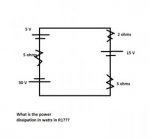cdynasty001
Member
- Location
- California
My question is: how do you calculate the power dissipation in watts in an in series circuit with three resistors and three voltage inputs? I would like to know how to calculate it across any of the resistors. I am confused as to how I am supposed to calculate this when there are three voltage inputs, one in between each resistor. I would appreciate some help.
R1 = 2 ohms. R2 = 5 ohms. R3 = 3 ohms.

R1 = 2 ohms. R2 = 5 ohms. R3 = 3 ohms.

